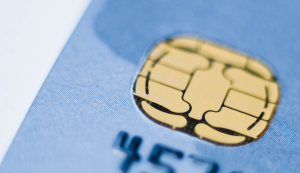We can help you get EMV compliant and make it affordable!
If you would like to become EMV compliant or not sure if you are compliant, contact us and we will be happy to assist you.
What is EMV?
 EMV chip technology is becoming the global standard for credit card and debit card payments. Named after its original developers (Europay, MasterCard® and Visa®), this smart chip technology features payment instruments (cards, mobile phones, etc.) with embedded microprocessor chips that store and protect cardholder data. This standard has many names worldwide and may also be referred to as: “chip and PIN” or “chip and signature.”
EMV chip technology is becoming the global standard for credit card and debit card payments. Named after its original developers (Europay, MasterCard® and Visa®), this smart chip technology features payment instruments (cards, mobile phones, etc.) with embedded microprocessor chips that store and protect cardholder data. This standard has many names worldwide and may also be referred to as: “chip and PIN” or “chip and signature.”
What is chip technology?
Chip technology is an evolution in our payment system that will help increase security, reduce fraud and enable the use of future value-added applications. Chip cards are standard bank cards that are embedded with a micro computer chip. Some may require a PIN instead of a signature to complete the transaction process.
What makes EMV different than the traditional magnetic stripe card payment?
Simply put, EMV (also referred to as chip-and-PIN, chip-and-signature, chip-and-choice, or generally as chip technology) is the most recent advancement in a global initiative to combat fraud and protect sensitive payment data in the card-present environment. A cardholder’s confidential data is more secure on a chip-enabled payment card than on a magnetic stripe (magstripe) card, as the former supports dynamic authentication, while the latter does not (the data is static). Consequently, data from a traditional magstripe card can be easily copied (skimmed) with a simple and inexpensive card reading device – enabling criminals to reproduce counterfeit cards for use in both the retail and the CNP environment. Chip (EMV) technology is effective in combating counterfeit fraud with its dynamic authentication capabilities (dynamic values existing within the chip itself that, when verified by the point-of-sale device, ensure the authenticity of the card)
What other incentives are there to accept chip cards?
In addition to the reduction of fraud and related chargebacks, there are other cost savings associated with EMV acceptance. The payment brands are doing their part to ensure that chip-bearing customers can pay at chip-enabled businesses. For example, Visa and MasterCard have issued upcoming rules and guidelines for processors and merchants to support EMV chip technology. Visa is introducing their Technology Innovation Program (TIP) to the U.S. region, which waives an annual PCI-DSS audit if 75 percent of the merchant’s Visa transactions are processed through a dual contactless and contact EMV certified device. MasterCard is introducing their PCI-DSS Compliance Validation Exemption Program to the U.S. region, which also waives the annual PCI-DSS audit if 75 percent of the merchants’ MasterCard transactions are processed through a dual contactless and contact EMV certified device.
Another Visa and MasterCard ruling is the liability shift. Once this goes into effect, merchants who have not made the investment in chip-enabled technology may be held financially liable for card-present fraud that could have been prevented with the use of a chip-enabled POS system.
Is this technology unique to the United States?
No. The chip technology standard for payment was first used in France in 1992. Today, there are more than 1 billion chip cards used around the world. The U.S. is one of the few industrialized nations that have not fully transitioned to this technology standard.
Why should I invest in chip card acceptance now?
Preventing the growth of fraudulent activity is one of the main reasons the industry is moving toward EMV technology. Chip cards make it difficult for fraud organizations to target cardholders and businesses alike. As a result, more and more chip cards are being introduced by U.S. financial institutions in order to support and switch over to this technology.
Are there any best practices for EMV migration?
- Training and product awareness at both the business and the employee level is crucial to a successful implementation. As EMV acceptance is very different than the traditional magstripe (the card is inserted into the terminal as opposed to swiped, for example), it is imperative that everyone is familiar with the new requirements to make the customer experience as smooth as possible.
- Don’t wait to migrate. You may begin to feel the pressure once the EMV card migration starts to reach its critical mass – with issuing banks beginning to issue chip cards to new and existing customers. Businesses that have not already migrated to EMV may consequently have to answer to their customers as to why they have to continue to swipe their new chip cards – especially when the market presents chip technology as the safer way to pay. Don’t wait until the last minute to migrate your business.
- Get a business plan together even before implementation begins. As equipment upgrades have the potential to be both costly and time consuming, it’s best to get started early. Figure out how much it’s going to cost, how long it’s going to take and plan accordingly. Also, when planning on how to update your systems to support this change, you will want to take a hard look at the cost vs. benefits of EMV. In some cases, fraud prevention alone may not deliver an acceptable ROI for effort required to implement this technology. With that, you will want to achieve other benefits when displacing your existing hardware or software solutions (e.g. update network connectivity, build out support for a loyalty or gift card program, include ability to accept contactless / mobile payment transactions, etc…).
What does EMV migration mean for card-not-present (CNP) merchants?
As EMV technology is adopted in the card present space, it is expected that fraud will also shift to the least secure channels, including CNP. From an online fraud perspective, it’s important that CNP businesses be prepared for this anticipated shift, as experienced in other regions that have already migrated toward chip card technology.
As fraud migrates online and fraudsters continue to get more sophisticated, the tools you have in place now may no longer be advanced enough to protect you and your customers. Strategy is key and it’s imperative to take the extra measures to know good customers and good customer behavior (beyond just AVS and CVV). It is recommended that you avoid the use of Address Verification and card validation values (security code) checks as your sole fraud detector since the false positive exposure can be high with these tools alone. You should consider strengthening the value of these tools by supporting additional technology to confirm and mitigate fraudulent activity.
A good fraud prevention tool will enable in-house management in real time, with no negative impact on your good customers’ experiences (those transactions that are not fraudulent in nature). Having the ability to control your fraud prevention at the business level, without the required assistance of IT support or third-party vendors, helps to ensure that your good transactions get through and your customer is not burdened with holds or declines based on suspected fraud. Simply put, you can prevent the fraudulent transactions without compromising the legitimate ones. This will protect you, your good customers, your bottom line and your brand.
How am I impacted by the liability shift?
With the liability shift, if a chip card is presented to a merchant that has not adopted a terminal that is certified for chip card acceptance, liability for counterfeit fraud may shift to the merchant’s acquirer – who may then pass this fee back to the merchant. The liability shift encourages chip adoption since any chip-on-chip transaction (chip card read by a chip certified terminal) provides the dynamic authentication data that helps to better protect all parties. In addition, if a counterfeit magnetic stripe card is presented at a chip certified terminal, the liability for the counterfeit fraud will be the responsibility of the card issuer.
EMV for Small Business
How is a chip card different from a traditional payment card? A chip payment card looks just like a traditional card with an embedded chip in addition to the standard magnetic stripe on the back of the card. What you see on the card is not the actual microchip but a protective overlay. The microchip provides an additional level of authenticity for the transaction.
What do I do when a customer presents a chip card?
Chip cards will still have a magnetic stripe during the U.S. migration to EMV to ensure that customers can continue to pay until all merchants have been given the time to upgrade their equipment.
How does EMV chip technology work?
Your EMV-enabled device will communicate with the chip inside the customer’s smart card to determine whether or not the card is authentic. Generally, the terminal will prompt the customer to sign or enter a PIN to validate their identity. This process enhances the authentication of both the card and cardholder, effectively reducing the possibility that your business will accept a counterfeit card or be held liable for a fraud-related chargeback.
Will I still be able to accept traditional credit and debit cards?
The Future Proof terminal has a magnetic stripe swipe reader and you can continue to accept payment cards that are not chip-enabled.
Chip cards will still have a magnetic stripe during the U.S. migration to EMV, to ensure that customers can continue to pay until all merchants have been given the time to upgrade their equipment.
How will chip cards impact the checkout experience at my business?
To process a chip card transaction, follow these four simple steps:
- Identify whether the card is a chip card.
- If it’s a chip card, the customer should then insert it into the chip card reader (slot on the bottom-front of the terminal) and leave it there until the transaction is complete.
- Follow the prompts displayed on the terminal.
- Let the customer complete the transaction by keying in a PIN or signing the receipt.
What do I do if my customer is using their chip card for the first time?
Make sure the card is inserted into the terminal’s chip reader slot face up with the chip first. The card must stay in the terminal’s chip reader slot for the duration of the transaction, which ends when the receipt is being printed. If the card is removed before the end of a transaction, the payment will not be processed.
Am I required to support EMV?
No, you are not required to support EMV in the U.S. region at this time.What if I have more questions?
We are happy to help! Feel free to contact us with any questions or concerns you may have.




You must be logged in to post a comment.